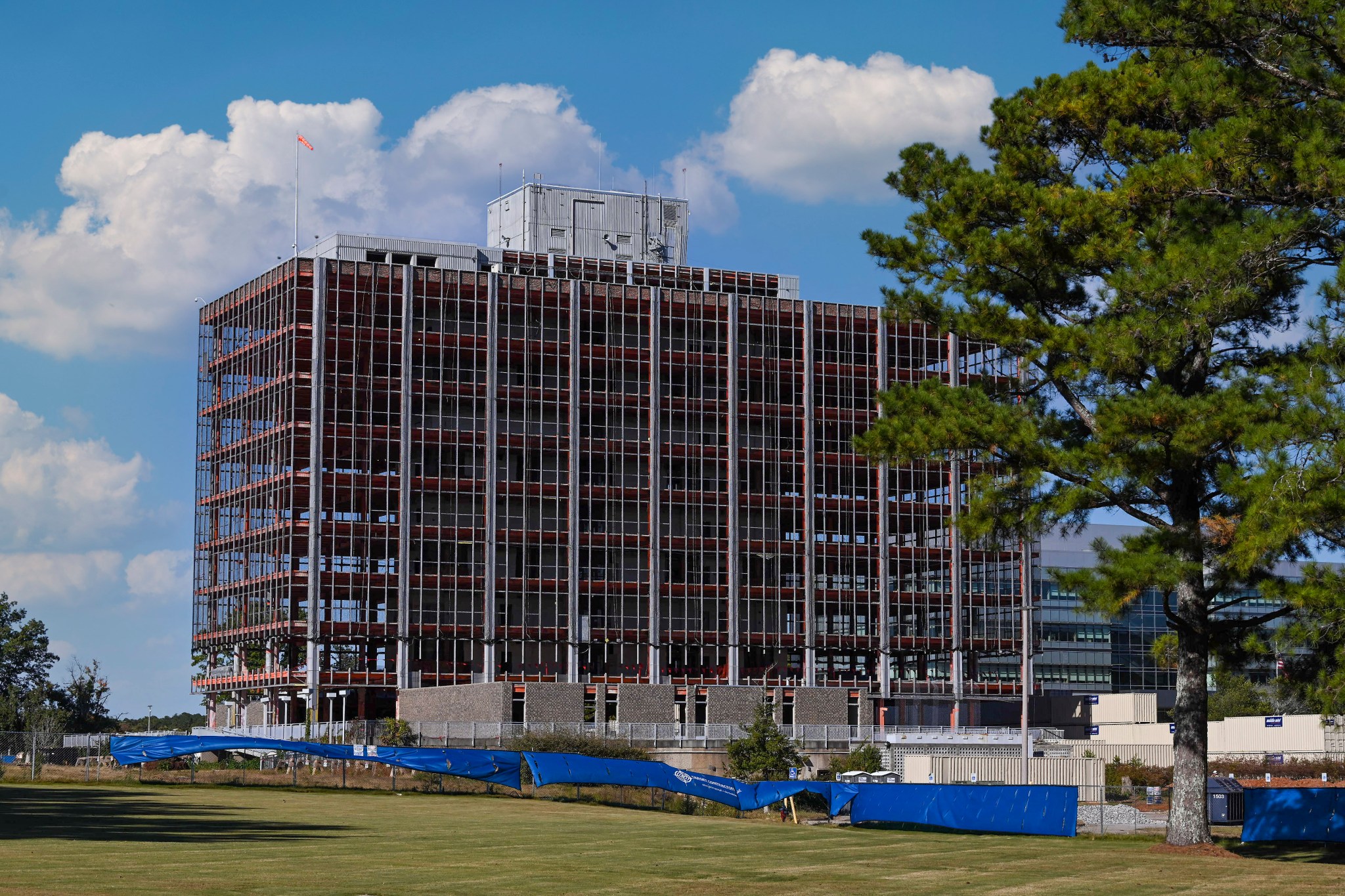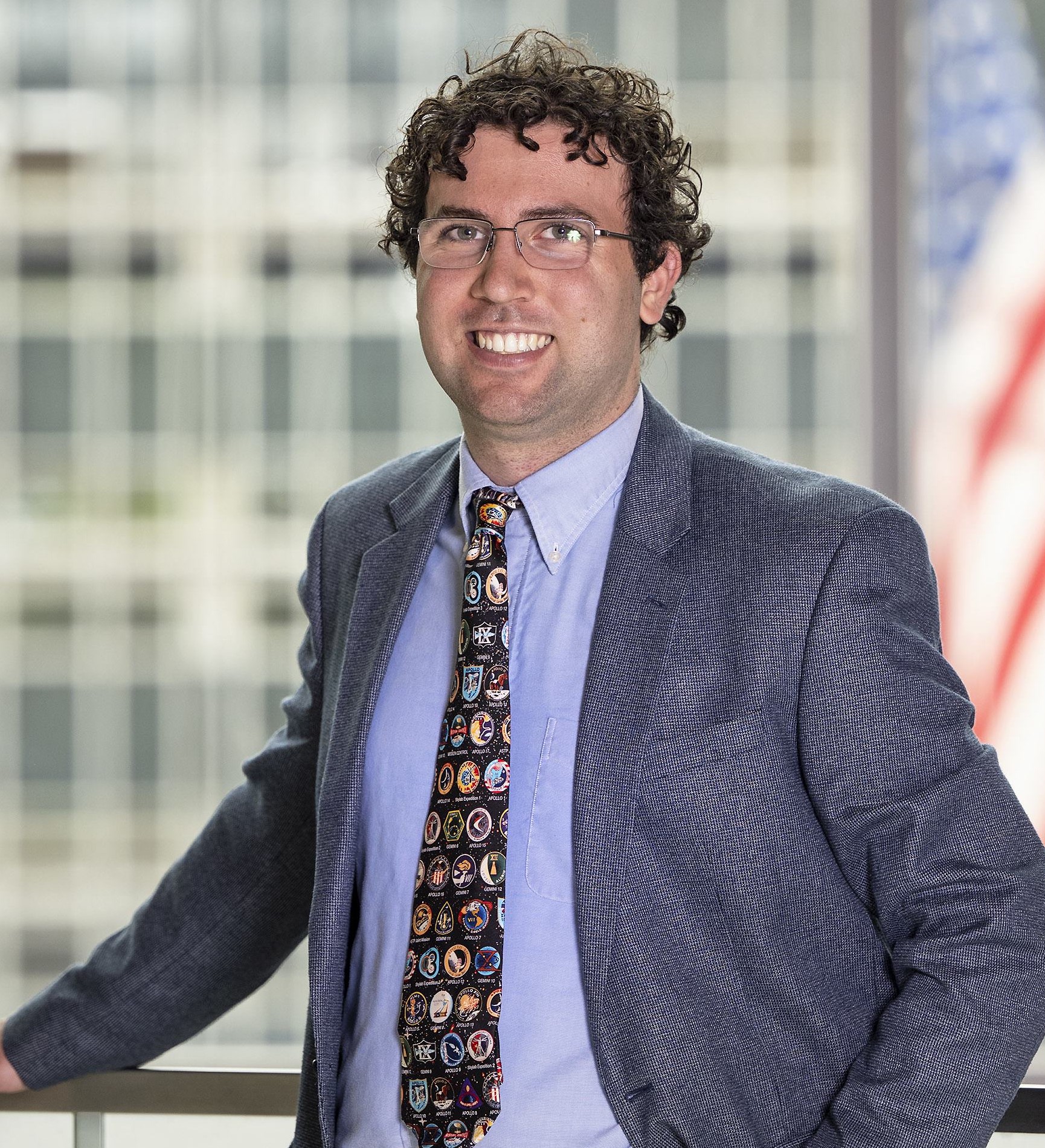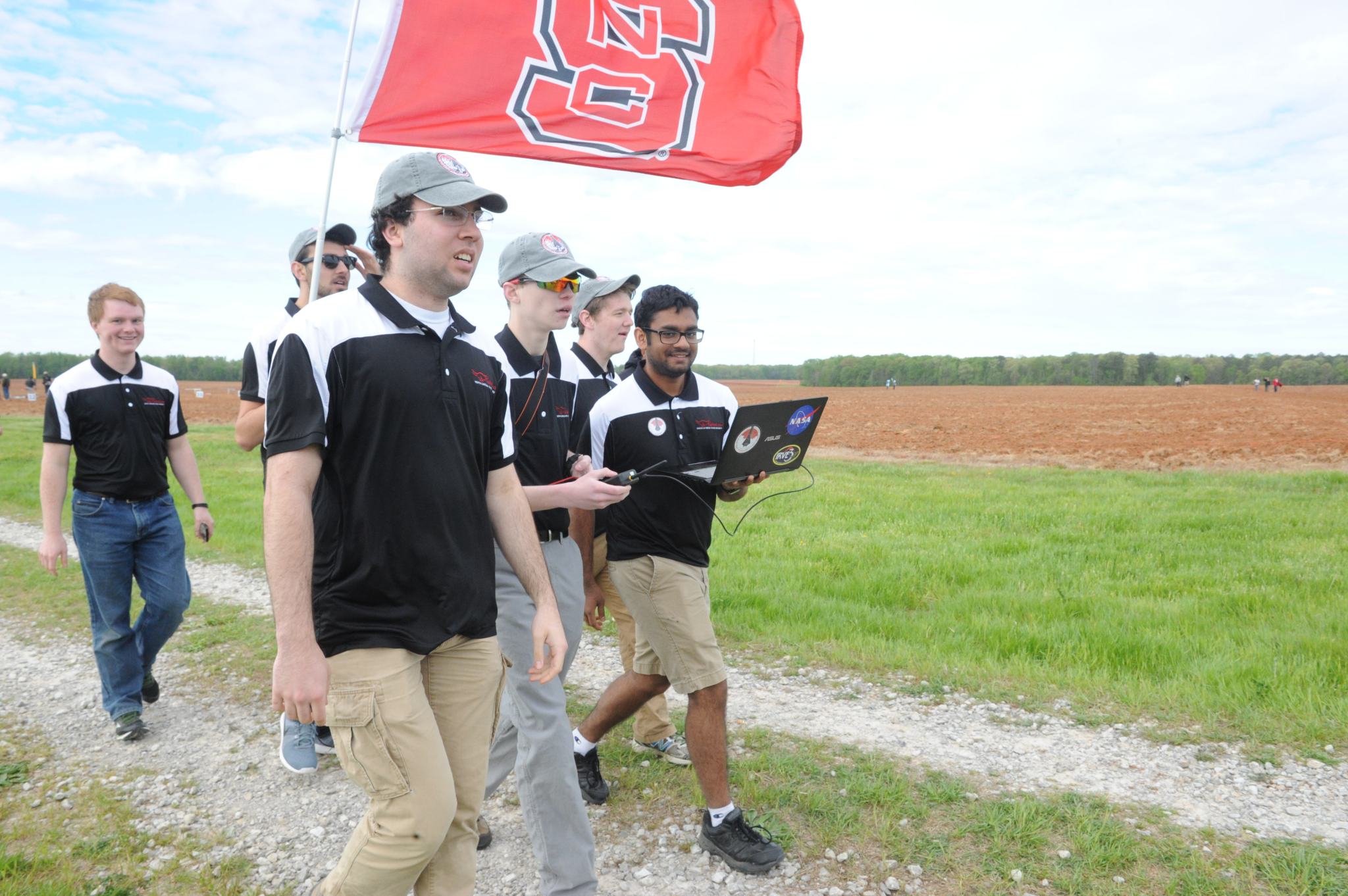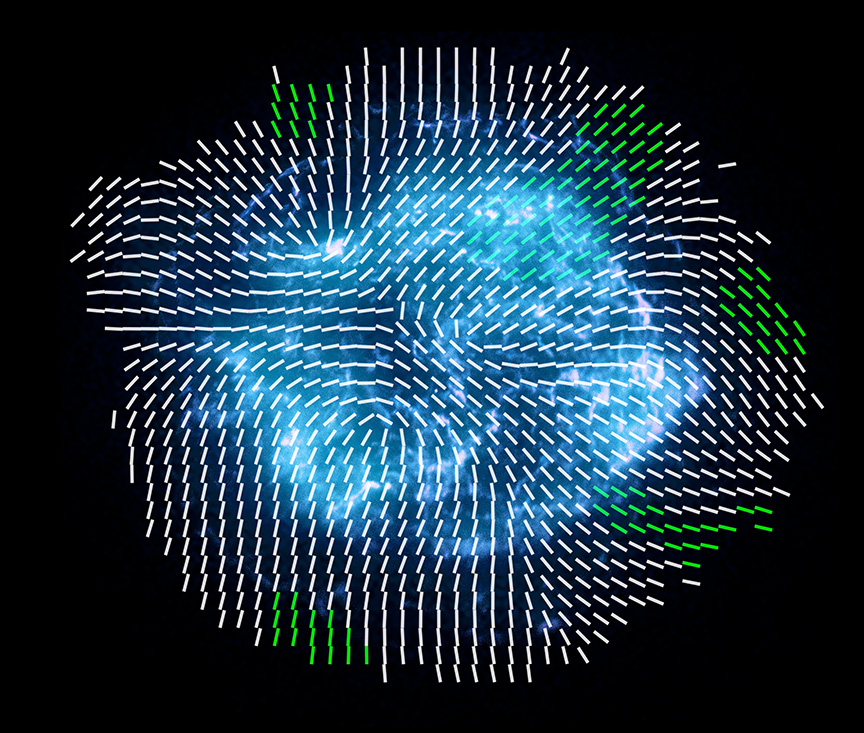In This Week’s Star
- Marshall 4200 Complex to Close Oct. 21-31 for Demolition Preparations; Team Members to Work Remotely
- Former Astronaut Dr. Jan Davis is Next Mission Success Speaker
- From Student to Employee, How NASA’s Rocket Competition Launches New Careers
- IXPE Helps Unlock the Secrets of Famous Exploded Star
- Chandra Finds Galaxy Cluster Collision on a ‘WHIM’
- NASA’s SpaceX Crew-4 Astronauts Safely Splash Down in Atlantic
- Research Scientist Eric Anderson Serves Others Through SERVIR
- Star Duo Forms ‘Fingerprint’ in Space, NASA’s Webb Finds
Marshall 4200 Complex to Close Oct. 21-31 for Demolition Preparations; Team Members to Work Remotely
By Rick Smith
As engineers prepare to level NASA’s Marshall Space Flight Center’s former executive building, the entire Building 4200 complex will be closed to all personnel from 5 p.m. Oct. 21 to Oct. 31 to enable demolition contractors to secure and make ready the site.
Building 4200, which anchored Marshall’s administrative complex on Redstone Arsenal, will be demolished at 7:30 a.m. on Saturday, Oct. 29. The implosion will be livestreamed on Marshall’s YouTube channel and social media. Viewing links will be provided closer to the event.
The week prior to the demolition, Target Contractors of Ladson, South Carolina, will clear the 4200 complex so they can properly rig explosive charges and conduct thorough site safety testing and inspection.
“We appreciate the patience and understanding of team members affected by this closure,” said Marshall Director Jody Singer. “We know the team is eager to sustain the cadence of onsite work that we’ve reestablished in the wake of COVID-19 protocols – but it’s equally important to keep everyone safe while we take these final steps, securing the demolition site and clearing the way for all the good work still to come.”
All Marshall team members quartered in buildings 4203, 4220, and 4221 – will be required to work remotely after 5 p.m. Oct. 21 through Oct. 31. No onsite parking will be available anywhere in the complex, and all door badge readers will be disabled. Roads around the area will be closed to traffic a few hours before and after the implosion.
ARS Aleut Remediation of Oak Ridge, Tennessee, a second demolition team responsible for the demolition of Building 4201, also will halt work during that period. Both demolition projects are being executed through the U.S. Army Corps of Engineers Facilities Reduction Program.
Marshall facilities planning leads said bringing the building down on a Saturday morning minimizes hazards to onsite workers, most of whom will be off duty for the weekend.
An early start offers another key advantage, said Megan Vansant, the project manager overseeing the demolition of both 4200 and 4201.
“The weather is generally calmer early in the morning, and the wind less likely to be gusty,” she said. “It’s just like preparing for a rocket launch – gauging your optimal window for the best chance of mission success.”
Should bad weather develop during the scheduled attempt, Vansant said engineers will reschedule the implosion for Sunday morning, Oct. 30. The 4200 complex will remain closed for post-implosion assessment of the site. Team members in buildings 4203, 4220, and 4221 may return to on-site work Tuesday, Nov. 1.
Building 4200 is the latest Marshall facility to undergo demolition, owing to its age and the costly upkeep of its outdated electrical system, plumbing, and other utilities. NASA erected the structure in the early 1960s to expedite development of a rocket powerful enough to loft Apollo crews to the Moon and conduct the center’s other business. Marshall has remained a world-class resource for NASA propulsion systems, space hardware, and scientific endeavors ever since.
Smith, a Manufacturing Technical Solutions employee, supports Marshall’s Office of Strategic Analysis & Communications.
Former Astronaut Dr. Jan Davis is Next Mission Success Speaker
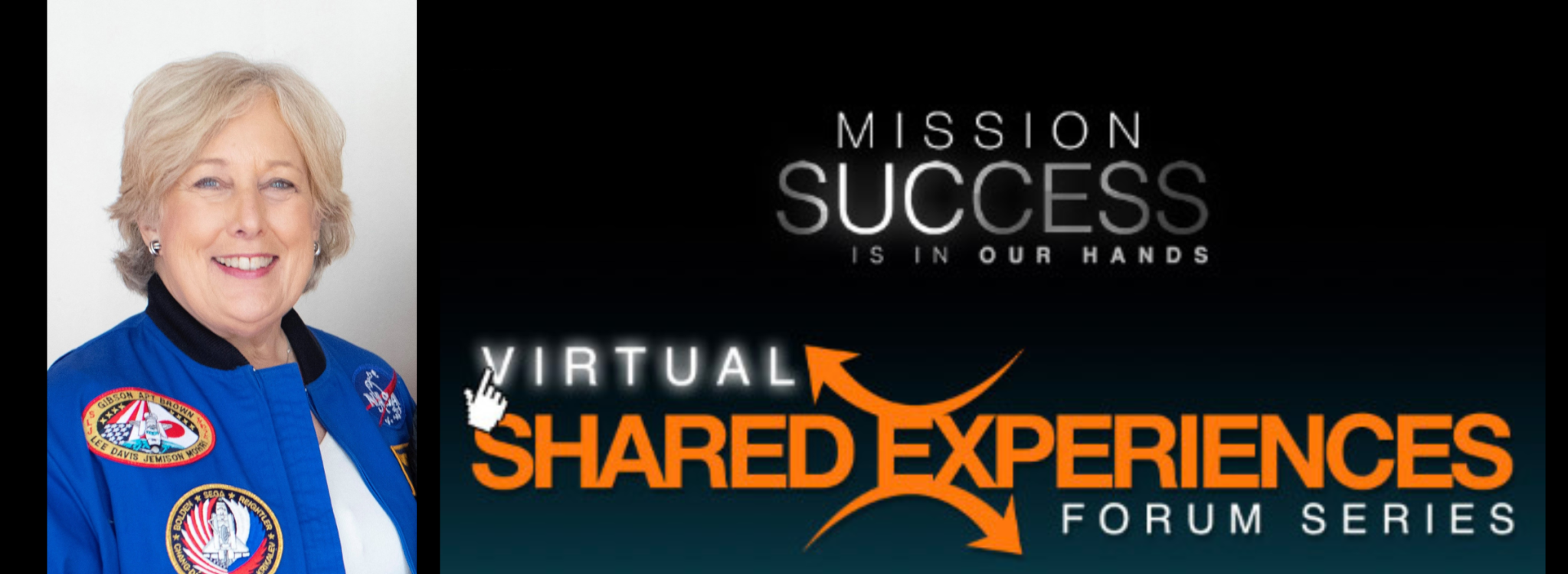
Former astronaut Dr. Jan Davis will be the next speaker in the Mission Success is in Our Hands virtual Shared Experience Forum series Oct. 20 at 11:30 a.m. The title of her presentation is “Common Themes We Can Learn from the Challenger and Columbia Accidents.” Davis has firsthand experience in the investigations into what caused the shuttle accidents and how issues were remedied for successful Return to Flight. She will take a fresh look at what can be learned from the accidents, using many resources in addition to her own experiences. Without going into too much technical detail on the physical causes of the accidents, Davis will discuss the common organizational, behavioral, and cultural themes that can be applied to future human spaceflight missions. Click here to join the meeting. Team members are encouraged to join the live presentation, as it will not be recorded. (NASA)
From Student to Employee, How NASA’s Rocket Competition Launches New Careers
By Lane Figueroa
NASA’s Student Launch rocket competition can provide participants with the knowledge and connections necessary to pursue careers in the aerospace industry. This rings true for John Inness, former student competitor turned NASA engineer.
Inness applied his six years of experience competing in Student Launch toward becoming a full-time employee at NASA’s Marshall Space Flight Center. In his role as a Guidance, Navigation, and Controls (GNC) engineer, he supports many NASA projects, including the Space Launch System (SLS) rocket, Solar Cruiser, Smartphone Video Guidance Sensor.
Inness recalls many benefits of Student Launch – which challenges middle, high, and college/university students to design, build, and fly high-powered amateur rockets and scientific payloads to an altitude between 4,000 and 6,000 feet and then safely return to Earth.
“Year after year, Student Launch provided our team with opportunities to network with and learn from NASA experts,” Inness said. “Through webinars, presentations, and hands-on experiences, I always left feeling better prepared for academic and professional endeavors.”
Inness, an alumnus of North Carolina State University in Raleigh, says one important benefit was the competition’s focus on NASA’s engineering design cycle. “We presented our plans to a team of NASA engineers during the Preliminary Design Review, the Critical Design Review, and many other milestones to better understand our rocket’s systems,” Inness said. “Not only do these reviews ensure positive results on launch day, but they also mirror NASA’s current methods to design and build spacecraft.”
In addition to forming connections with NASA engineers and leaders, the advanced requirements of Student Launch helped steer Inness toward his current career supporting the Artemis Program.
Through Artemis, NASA will explore the lunar surface deeper than ever before, while also landing the first woman and person of color on the Moon. Inness develops components for the SLS rocket, the launch vehicle for the Artemis missions, including comparing models of the GNS design to real world testing, conducting analysis on controllability of future SLS configurations, and testing the Flight Termination System battery.
Since his days as a student, Inness has now come full circle. He supports Student Launch as a volunteer tour guide, a milestone reviewer, and he assists with launch day activities. His story is evidence of the mutual benefits gained by both student competitors and the aerospace industry.
“My time in Student Launch helped develop the skills, connections, and drive needed to secure a job with NASA,” said Inness. “This is also true for several of my teammates and friends throughout the years, many now working in the aerospace industry.”
Student Launch is part of NASA’s Artemis Student Challenges, which aims to equip the future workforce with the knowledge and skills needed to support Artemis missions. NASA’s Southeast Regional Office of STEM Engagement manages Student Launch with Marshall serving as the host center. NASA’s Space Operations and Exploration Systems Development mission directorates, along with Northrop Grumman and the Huntsville chapter of the National Space Club, provide funding and leadership for the initiative.
NASA has announced the 69 teams from 25 states and Puerto Rico competing in the 2023 season of Student Launch. This year’s challenge concludes with an on-site launch event at Bragg Farms in Toney, Alabama, April 13-15, 2023.
Figueroa, a Media Fusion employee, supports Marshall’s Office of Strategic Analysis & Communications.
IXPE Helps Unlock the Secrets of Famous Exploded Star
For the first time, astronomers have measured and mapped polarized X-rays from the remains of an exploded star, using NASA’s Imaging X-ray Polarimetry Explorer (IXPE). The findings, which come from observations of a stellar remnant called Cassiopeia A, shed new light on the nature of young supernova remnants, which accelerate particles close to the speed of light.
Launched on Dec. 9, 2021, IXPE, a collaboration between NASA and the Italian Space Agency, is the first satellite that can measure the polarization of X-ray light with this level of sensitivity and clarity.
All forms of light – from radio waves to gamma rays – can be polarized. Unlike the polarized sunglasses we use to cut the glare from sunlight bouncing off a wet road or windshield, IXPE’s detectors maps the tracks of incoming X-ray light. Scientists can use these individual track records to figure out the polarization, which tells the story of what the X-rays went through.
Cassiopeia A (Cas A for short) was the first object IXPE observed after it began collecting data. One of the reasons Cas A was selected is that its shock waves – like a sonic boom generated by a jet – are some of the fastest in the Milky Way. The shock waves were generated by the supernova explosion that destroyed a massive star after it collapsed. Light from the blast swept past Earth more than three hundred years ago.
“Without IXPE, we have been missing crucial information about objects like Cas A,” said Pat Slane at the Center for Astrophysics | Harvard & Smithsonian, who leads the IXPE investigations of supernova remnants. “This result is teaching us about a fundamental aspect of the debris from this exploded star – the behavior of its magnetic fields.”
Magnetic fields, which are invisible, push and pull on moving charged particles like protons and electrons. Closer to home, they are responsible for keeping magnets stuck to a kitchen fridge. Under extreme conditions, such as an exploded star, magnetic fields can boost these particles to near-light-speed.
Despite their super-fast speeds, particles swept up by shock waves in Cas A do not fly away from the supernova remnant because they are trapped by magnetic fields in the wake of the shocks. The particles are forced to spiral around the magnetic field lines, and the electrons give off an intense kind of light called “synchrotron radiation,” which is polarized.
By studying the polarization of this light, scientists can “reverse engineer” what’s happening inside Cas A at very small scales – details that are difficult or impossible to observe in other ways. The angle of polarization tells us about the direction of these magnetic fields. If the magnetic fields close to the shock fronts are very tangled, the chaotic mix of radiation from regions with different magnetic field directions will give off a smaller amount of polarization.
Previous studies of Cas A with radio telescopes have shown that the radio synchrotron radiation is produced in regions across almost the entire supernova remnant. Astronomers found that only a small amount of the radio waves were polarized – about 5%. They also determined that the magnetic field is oriented radially, like the spokes of a wheel, spreading out from near the center of the remnant towards the edge.
Data from NASA’s Chandra X-ray Observatory, on the other hand, show that the X-ray synchrotron radiation mainly comes from thin regions along the shocks, near the circular outer rim of the remnant, where the magnetic fields were predicted to align with the shocks. Chandra and IXPE use different kinds of detectors and have different levels of angular resolution, or sharpness. Launched in 1999, Chandra’s first science image was also of Cas A.
Before IXPE, scientists predicted X-ray polarization would be produced by magnetic fields that are perpendicular to magnetic fields observed by radio telescopes.
Instead, IXPE data show that the magnetic fields in X-rays tend to be aligned in radial directions even very close to the shock fronts. The X-rays also reveal a lower amount of polarization than radio observations showed, which suggests that the X-rays come from turbulent regions with a mix of many different magnetic field directions.
“These IXPE results were not what we expected, but as scientists we love being surprised,” says Dr. Jacco Vink of the University of Amsterdam and lead author of the paper describing the IXPE results on Cas A. “The fact that a smaller percentage of the X-ray light is polarized is a very interesting – and previously undetected – property of Cas A.”
The IXPE result for Cas A is whetting the appetite for more observations of supernova remnants that are currently underway. Scientists expect each new observed object will reveal new answers – and pose even more questions – about these important objects that seed the Universe with critical elements.
“This study enshrines all the novelties that IXPE brings to astrophysics,” said Dr. Riccardo Ferrazzoli with the Italian National Institute for Astrophysics/Institute for Space Astrophysics and Planetology in Rome. “Not only did we obtain information on X-ray polarization properties for the first time for these sources, but we also know how these change in different regions of the supernova. As the first target of the IXPE observation campaign, Cas A provided an astrophysical ‘laboratory’ to test all the techniques and analysis tools that the team has developed in recent years.”
“These results provide a unique view of the environment necessary to accelerate electrons to incredibly high energies,” said co-author Dmitry Prokhorov, also of the University of Amsterdam. “We are just at the beginning of this detective story, but so far the IXPE data are providing new leads for us to track down.”
IXPE is a collaboration between NASA and the Italian Space Agency with partners and science collaborators in 12 countries. Ball Aerospace, headquartered in Broomfield, Colorado, manages spacecraft operations together with the University of Colorado’s Laboratory for Atmospheric and Space sciences, which operates IXPE for NASA’s Marshall Space Flight Center.
Chandra Finds Galaxy Cluster Collision on a ‘WHIM’
Astronomers taking inventory of the material in the local universe keep coming up short. A new result from NASA’s Chandra X-ray Observatory about a system of colliding galaxy clusters may help explain this shortfall.
Although scientists know a great deal about the composition of the universe, there has been a vexing problem they have struggled to explain – there is a significant amount of matter that has not yet been accounted for.
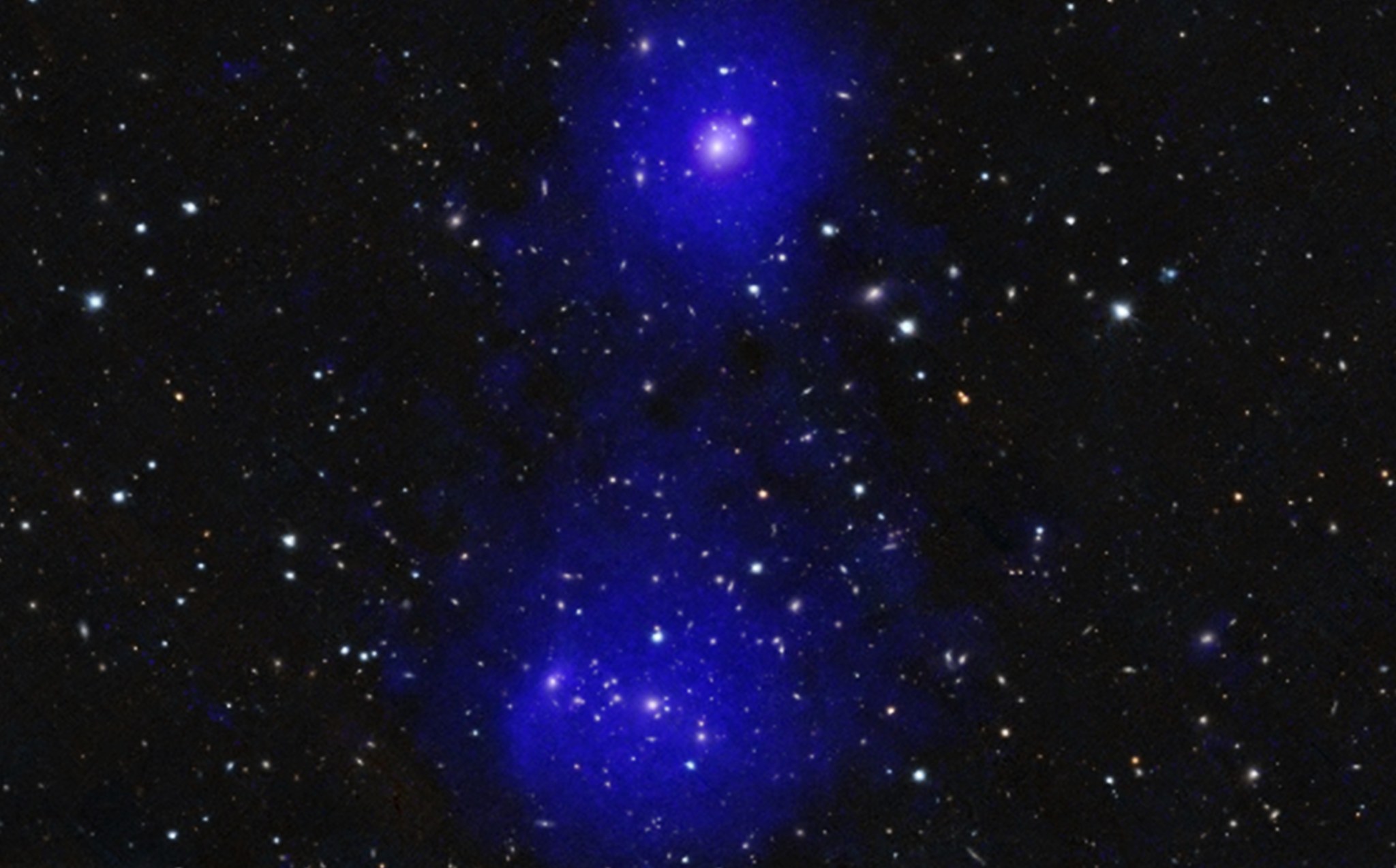
This missing mass is not the invisible dark matter, which makes up a majority of the matter in the universe. This is a separate puzzle where about a third of the “normal” matter that was created in the first billion years or so after the big bang has yet to be detected by observations of the local universe, that is, in regions less than a few billion light-years from Earth. This matter is made up of hydrogen, helium, and other elements and makes up objects like stars, planets, and humans.
Scientists have proposed that at least some of this missing mass could be hidden in gigantic strands, or filaments, of warm to hot (temperatures of 10,000 to 10,000,000 kelvins) gas in the space in between galaxies and clusters of galaxies. They have dubbed this the “warm-hot intergalactic medium,” or WHIM.
A team of astronomers using Chandra to observe a system of colliding galaxy clusters has likely found evidence of this WHIM residing in the space between them.
“Finding these filaments of missing matter has proven to be exceptionally difficult, and only a few examples are known,” said Arnab Sarkar of the Center for Astrophysics | Harvard & Smithsonian (CfA) in Cambridge, Massachusetts, who led this study. “We are excited that we have likely pinpointed another.”
The researchers used Chandra to study Abell 98, which contains colliding galaxy clusters about 1.4 billion light-years from Earth. The Chandra data reveals a bridge of X-ray emission between two of the colliding clusters containing gas at a temperature of about 20 million kelvins and cooler gas with a temperature of about 10 million kelvins. The hotter gas in the bridge is likely from gas in the two clusters overlapping with each other. The temperature and density of the cooler gas agree with predictions for the hottest and densest gas in the WHIM.
In addition, the Chandra data shows the presence of a shock wave, which is similar to a sonic boom from a supersonic plane. This shock wave is driven by and located ahead of one of the galaxy clusters as it is starting to collide with another cluster. This is the first time astronomers have found such a shock wave in the early stages of a galaxy cluster collision, before the centers of the cluster pass by one another.
“We think this shock wave is an important discovery because our models have predicted such features should be there, but we haven’t seen one until now,” said coauthor Scott Randall, also of CfA. “They’re a key part of the early collision process that will eventually lead to a merger of the clusters.”
This shock wave may be directly connected to the discovery of the WHIM in Abell 98 because it has heated the gas in between the clusters as they collide. This may have raised the temperature of the gas in the WHIM filament – estimated to contain some 400 billion times the mass of the Sun – high enough to be detected with Chandra data.
Galaxy clusters – which contain thousands of galaxies, huge amounts of hot gas, and enormous reservoirs of dark matter – are the largest structures in the universe held together by gravity. Scientists think they are able to reach their colossal size by merging with one another over millions or billions of years.
“When galaxy clusters collide, we get a chance to see extreme physics that we rarely see in any other cosmic setting,” said Yuanyuan Su, a co-author from the University of Kentucky.
A paper describing this result by Sarkar et al was published in The Astrophysical Journal Letters and is available at https://arxiv.org/abs/2208.03401. Other authors on the paper are Gabriella E. Alvarez (CfA), Craig Sarazin (University of Virginia, Charlottesville, Virginia), Paul Nulsen (CfA), Elizabeth Blanton (Boston University, Boston, Massachusetts), William Forman (CfA), Christine Jones (CfA), Esra Bulbul (Max Planck Institute for Extraterrestrial Physics, Garching, Germany), John Zuhone (CfA), Felipe Andrade-Santos (CfA), Ryan Johnson (Gettysburg College, Gettysburg, Pennsylvania), and Priyanka Chakraborty (CfA).
Additional evidence for the WHIM filament between these two clusters was found with the Japan Aerospace Exploration Agency’s Suzaku, in a new paper led by Gabriella Alvarez, also of CfA. Their paper also gives evidence for the WHIM on the opposite side of the cluster that is leading the collision. These two detections of the WHIM indicate that the clusters are located along a colossal structure that is 13 million light-years long. The paper by Alvarez was recently accepted for publication in The Astrophysical Journal and is available at https://arxiv.org/abs/2206.08430.
NASA’s Marshall Space Flight Center manages the Chandra program. The Smithsonian Astrophysical Observatory’s Chandra X-ray Center controls science operations from Cambridge, Massachusetts, and flight operations from Burlington, Massachusetts.
Read more from NASA’s Chandra X-ray Observatory.
NASA’s SpaceX Crew-4 Astronauts Safely Splash Down in Atlantic
NASA’s SpaceX Crew-4 astronauts aboard the Dragon spacecraft safely splashed down Oct. 14 off the coast of Jacksonville, Florida, completing the agency’s fourth commercial crew mission to the International Space Station. The international crew of four spent 170 days in orbit.
NASA astronauts Bob Hines, Kjell Lindgren, and Jessica Watkins and European Space Agency astronaut Samantha Cristoforetti returned to Earth in a parachute-assisted splashdown at 3:55 p.m. CDT. Teams aboard SpaceX recovery vessels retrieved the spacecraft and astronauts.

“Welcome home Crew-4! This international crew has spent nearly six months on the International Space Station conducting science for the benefit of all. Their work aboard the orbiting laboratory will help prepare future explorers for future space missions,” said NASA Administrator Bill Nelson. “Working and living on the space station is the opportunity of a lifetime, but it also requires these explorers to make sacrifices, especially time away from loved ones. Kjell, Bob, Jessica and Samantha, thank you for your contributions over the past six months to science, innovation, and discovery!”
The Crew-4 mission launched April 27 on a Falcon 9 rocket from NASA’s Kennedy Space Center. Less than 16 hours later, Dragon docked to the Harmony module’s space-facing port. The astronauts undocked from the same port at 12:05 p.m. Oct. 14 to begin the trip home.
Hines, Lindgren, Watkins, and Cristoforetti traveled 72,168,935 miles during their mission, spent 170 days aboard the space station, and completed 2,720 orbits around Earth. Lindgren has logged 311 days in space over his two flights, and with the completion of their flight today, Cristoforetti has logged 369 days in space on her two flights, making her second on the all-time list for most days in space by a woman. The Crew-4 mission was the first spaceflight for Hines and Watkins.
Throughout their mission, the Crew-4 astronauts contributed to a host of science and maintenance activities and technology demonstrations. Cristoforetti completed two spacewalks with Roscosmos cosmonaut Oleg Artemyev to perform station maintenance and upgrades.
Crew-4 continued work on investigations documenting how improvements to the space diet affect immune function and the gut microbiome, determining the effect of fuel temperature on the flammability of a material, exploring possible adverse effects on astronaut hearing from equipment noise and microgravity, and studying whether additives increase or decrease the stability of emulsions. The astronauts also investigated microgravity-induced changes in the human immune system similar to aging, tested a novel water-reclamation membrane, and examined a concrete alternative made with a material found in lunar and Martian dust.
The spacecraft, named Freedom by Crew-4, will return to Florida for inspection and processing at SpaceX’s Dragon Lair, where teams will examine the spacecraft’s data and performance throughout the flight.
The Crew-4 flight is part of NASA’s Commercial Crew Program and its return to Earth follows on the heels of NASA’s SpaceX Crew-5 launch, which docked to the station Oct. 6, beginning another science expedition.
The goal of NASA’s Commercial Crew Program is safe, reliable, and cost-effective transportation to and from the International Space Station. This already has provided additional research time and has increased the opportunity for discovery aboard humanity’s microgravity testbed for exploration, including helping NASA prepare for human exploration of the Moon and Mars.
Learn more about NASA’s Commercial Crew program here.
Research Scientist Eric Anderson Serves Others Through SERVIR
(This is the fifth in a series of profiles on early career scientists in the Earth Science Branch at NASA’s Marshall Space Flight Center.)
By Dauna Coulter
When he was growing up, Eric Anderson wanted to be a paleontologist, astronaut, or the first person to walk on Mars. If you ask him when he gave up on those goals, he answers, “When I found something better!”
That something better doesn’t involve walking on another planet, but it does get him all around this one.
Working with NASA’s Marshall Space Flight Center, Anderson is the associate chief scientist and disasters theme lead for SERVIR, a joint NASA and USAID-led program that helps countries in Asia, Africa, and the Americas use information from Earth observing satellites to manage disasters, agriculture, water, ecosystems, and land use.
Anderson was a gymnast from the time he could walk until age 15. He competed at a national level a few times and coached some.
Two things clicked for him in high school: physics and environmental science. Anderson majored in the latter in college, and he also found time to do community service. He is still doing it, much further from home.
Anderson is passionate about helping people across the globe use satellite data to meet their most pressing needs. At age 36, he has already learned a lot about how to best do that.
“Making satellite data freely available is a start, but we need to make free data useful and relevant to the unique issues decision-makers are trying to solve,” he said. “And it has to work well within the region’s current systems.”
Anderson emphasizes the importance of including local agencies and officials every step of the way in creating applications and tools for their use.
“We must understand our users as people with their own sets of values, unique day-to-day challenges, and personal and institutional goals,” he said. “We must listen to their needs, work with them to meet those needs, and get their feedback when they use our services in real time. Then we can improve our approaches based on that feedback.”
Now a father of two, Anderson enjoys family time, which includes hiking, biking, kite flying, and throwing frisbees. He’s thankful for his wife and children. He’s also thankful for his parents.
“They were good to each other,” Anderson said. “We saw them argue and make up. We saw love. We never felt unsafe. They were entrepreneurs who owned their own business, and really did it for us. They taught us to keep strong and flexible bodies and minds. As authoritative rather than authoritarian parents, they led us to become more independent.”
Anderson is a pretty good parent himself.
“When my daughter was born, I gradually but forcefully I realized I was no longer number one,” he said. “I changed my approach and became more balanced, taking time for family and becoming a little less emotionally invested in work.”
He sees room for self-improvement, and says he wants to better himself by being more decisive and ruminating less. He’s also working on being more focused.
While Anderson may not end up being first to take a walk on Mars, he’s surely going places.
Coulter, a Media Fusion employee, supports Marshall’s Office of Strategic Analysis & Communications.
Star Duo Forms ‘Fingerprint’ in Space, NASA’s Webb Finds
A new image from NASA’s James Webb Space Telescope reveals a remarkable cosmic sight: at least 17 concentric dust rings emanating from a pair of stars. Located just over 5,000 light-years from Earth, the duo is collectively known as Wolf-Rayet 140.
Each ring was created when the two stars came close together and their stellar winds (streams of gas they blow into space) met, compressing the gas and forming dust. The stars’ orbits bring them together about once every eight years; like the growth of rings of a tree’s trunk, the dust loops mark the passage of time.
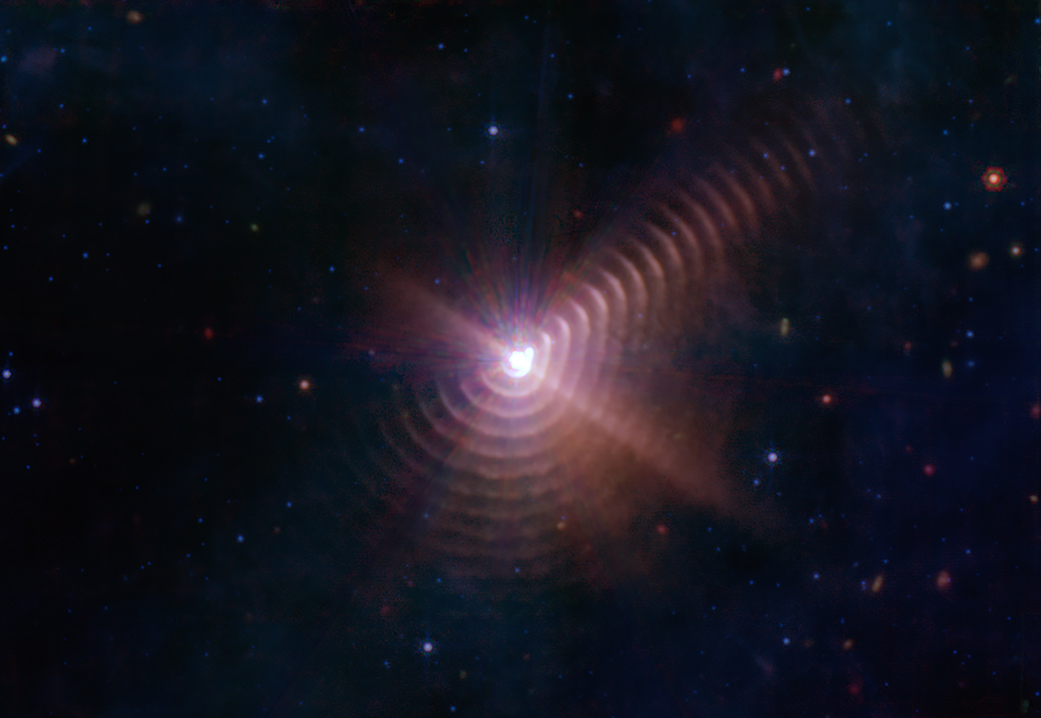
“We’re looking at over a century of dust production from this system,” said Ryan Lau, an astronomer at NSF’s NOIRLab and lead author of a new study about the system, published today in the journal Nature Astronomy. “The image also illustrates just how sensitive this telescope is. Before, we were only able to see two dust rings, using ground-based telescopes. Now we see at least 17 of them.”
In addition to Webb’s overall sensitivity, its Mid-Infrared Instrument (MIRI) is uniquely qualified to study the dust rings – or what Lau and his colleagues call shells, because they are thicker and wider than they appear in the image. Webb’s science instruments detect infrared light, a range of wavelengths invisible to the human eye. MIRI detects the longest infrared wavelengths, which means it can often see cooler objects – including the dust rings – than Webb’s other instruments can. MIRI’s spectrometer also revealed the composition of the dust, formed mostly from material ejected by a type of star known as a Wolf-Rayet star.
MIRI was developed through a 50-50 partnership between NASA and the European Space Agency (ESA). The Jet Propulsion Laboratory led the effort for NASA, and a multinational consortium of European astronomical institutes contributed for ESA.
A Wolf-Rayet star is an O-type star, born with at least 25 times more mass than our Sun, that is nearing the end of its life, when it will likely collapse and form a black hole. Burning hotter than in its youth, a Wolf-Rayet star generates powerful winds that push huge amounts of gas into space. The Wolf-Rayet star in this particular pair may have shed more than half its original mass via this process.
Transforming gas into dust is somewhat like turning flour into bread: It requires specific conditions and ingredients. The most common element found in stars, hydrogen, can’t form dust on its own. But because Wolf-Rayet stars shed so much mass, they also eject more complex elements typically found deep in a star’s interior, including carbon. The heavy elements in the wind cool as they travel into space and are then compressed where the winds from both stars meet, like when two hands knead dough.
Some other Wolf-Rayet systems form dust, but none is known to make rings like Wolf-Rayet 140 does. The unique ring pattern forms because the orbit of the Wolf-Rayet star in WR 140 is elongated, not circular. Only when the stars come close together – about the same distance between Earth and the Sun – and their winds collide is the gas under sufficient pressure to form dust. With circular orbits, Wolf-Rayet binaries can produce dust continuously.
Lau and his co-authors think WR 140’s winds also swept the surrounding area clear of residual material they might otherwise collide with, which may be why the rings remain so pristine rather than smeared or dispersed. There are likely even more rings that have become so faint and dispersed, not even Webb can see them in the data.
Wolf-Rayet stars may seem exotic compared to our Sun, but they may have played a role in star and planet formation. When a Wolf-Rayet star clears an area, the swept-up material can pile up at the outskirts and become dense enough for new stars to form. There is some evidence the Sun formed in such a scenario.
Using data from MIRI’s Medium Resolution Spectroscopy mode, the new study provides the best evidence yet that Wolf-Rayet stars produce carbon-rich dust molecules. What’s more, the preservation of the dust shells indicates that this dust can survive in the hostile environment between stars, going on to supply material for future stars and planets.
The catch is that while astronomers estimate that there should be at least a few thousand Wolf-Rayet stars in our galaxy, only about 600 have been found to date.
“Even though Wolf-Rayet stars are rare in our galaxy because they are short lived as far as stars go, it’s possible they’ve been producing lots of dust throughout the history of the galaxy before they explode and/or form black holes,” said Patrick Morris, an astrophysicist at Caltech in Pasadena, California, and a co-author of the new study. “I think with NASA’s new space telescope we’re going to learn a lot more about how these stars shape the material between stars and trigger new star formation in galaxies.”
JWST is the world’s premier space science observatory. Webb will solve mysteries in our solar system, look beyond to distant worlds around other stars, and probe the mysterious structures and origins of our universe and our place in it. Webb is an international program led by NASA with its partners, ESA and the Canadian Space Agency.
George Rieke with the University of Arizona is the MIRI U.S. science team lead. Gillian Wright with the UK Astronomy Technology Centre is the MIRI European principal investigator. Alistair Glasse with UK ATC is the MIRI instrument scientist, and Michael Ressler is the U.S. project scientist at JPL. Laszlo Tamas with UK ATC manages the European Consortium. The MIRI cryocooler development was led and managed by JPL, in collaboration with NASA’s Goddard Space Flight Center and Northrop Grumman in Redondo Beach, California. Caltech manages JPL for NASA.


























